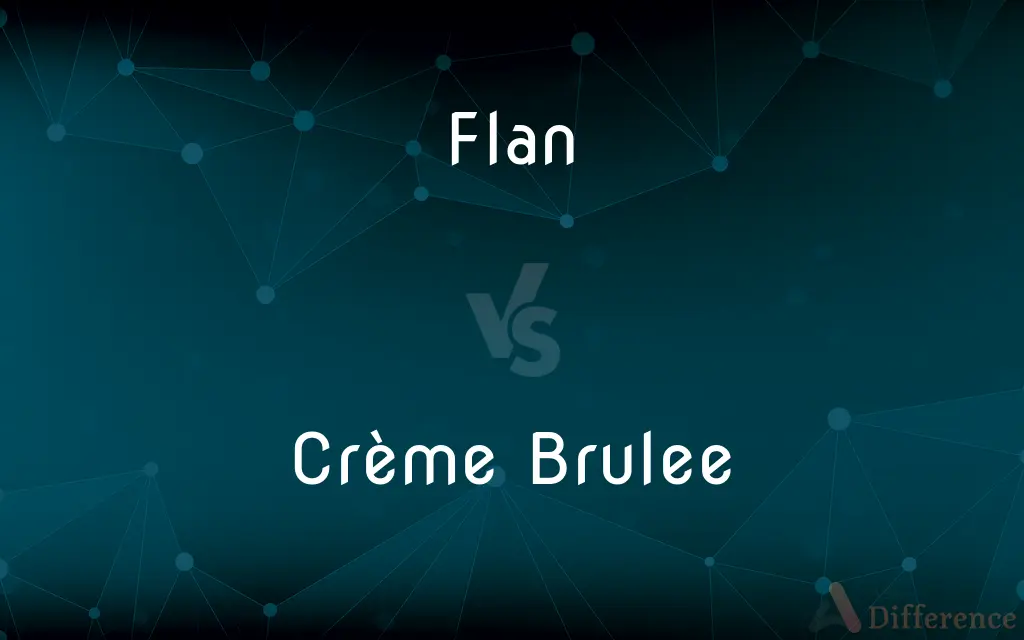Flan vs. Crème Brulee — What's the Difference?
By Tayyaba Rehman — Published on January 25, 2024
Flan is a custard dessert with a caramel topping, while Crème Brûlée is a custard with a caramelized sugar crust on top.

Difference Between Flan and Crème Brulee
Table of Contents
ADVERTISEMENT
Key Differences
Flan, also known as caramel custard, is a creamy dessert made with a base of eggs, milk, and sugar, topped with a soft caramel sauce. Crème Brûlée, French for "burnt cream," consists of a rich custard base topped with a contrasting layer of hard caramelized sugar.
The texture of flan is smooth and silky with a liquid caramel topping. Crème Brûlée, on the other hand, is known for its creamy custard beneath a hard, crispy caramelized sugar top, created by torching sugar just before serving.
Flan is traditionally served cold and is a common dessert in Latin American, Spanish, and Filipino cuisines. Crème Brûlée is typically served at or slightly below room temperature and is a staple in French cuisine.
The preparation of flan involves baking the custard in a water bath to achieve its delicate texture, with caramel poured into the mold before adding the custard mixture. Crème Brûlée is also baked in a water bath, but the sugar on top is caramelized after the custard is cooked and cooled.
Both desserts share similarities in their custard bases but differ significantly in texture, serving temperature, and the caramel component's execution.
ADVERTISEMENT
Comparison Chart
Texture
Smooth custard with liquid caramel topping
Creamy custard with a hard, caramelized sugar crust
Serving Temperature
Served cold
Served at or slightly below room temperature
Origin
Popular in Latin American, Spanish, Filipino cuisines
A staple of French cuisine
Caramel Component
Soft caramel sauce on top
Hard, crispy caramelized sugar layer
Preparation
Baked in water bath, caramel added first
Baked in water bath, sugar caramelized after cooking
Compare with Definitions
Flan
A creamy custard dessert topped with caramel.
For dessert, we had a deliciously smooth flan.
Crème Brulee
Served slightly below room temperature.
Crème brûlée is best enjoyed slightly chilled.
Flan
Known for its silky texture and caramel sauce.
The flan's caramel sauce complemented its creamy base perfectly.
Crème Brulee
Known for its rich custard base.
The rich custard base of the crème brûlée was perfectly creamy.
Flan
Typically served cold, popular in various cuisines.
In our family, flan is a traditional dessert served at gatherings.
Crème Brulee
The sugar top is caramelized using a torch.
We caramelized the sugar on the crème brûlée with a kitchen torch.
Flan
Prepared by baking in a water bath.
I baked the flan in a water bath to achieve its delicate texture.
Crème Brulee
A custard dessert with a caramelized sugar crust.
I love the contrasting textures in crème brûlée.
Flan
Features a caramel layer at the bottom of the mold.
The flan is inverted before serving to reveal the caramel layer.
Crème Brulee
A classic French dessert.
For our French-themed dinner, we made crème brûlée.
Flan
A custard that is baked in a caramel-lined mold and served chilled with the caramel side up. Also called crème caramel.
Flan
A tart with a filling of custard, fruit, or cheese.
Flan
Baked tart with sweet or savoury filling in an open-topped pastry case. Compare quiche.
Flan
A dessert of congealed custard, often topped with caramel, especially popular in Spanish-speaking countries.
Flan
Open pastry filled with fruit or custard
Common Curiosities
What cuisines is flan commonly associated with?
Flan is commonly associated with Latin American, Spanish, and Filipino cuisines.
Is crème brûlée always served cold?
Crème brûlée is typically served at or slightly below room temperature.
What is the main ingredient in flan?
The main ingredients in flan are eggs, milk, and sugar.
Is flan difficult to make?
Flan requires careful preparation, especially when making the caramel, but it's not overly difficult.
Can flan be flavored with other ingredients?
Yes, flan can be flavored with ingredients like vanilla, citrus, or coffee.
What does crème brûlée taste like?
Crème brûlée has a rich, creamy custard flavor with a sweet, slightly burnt sugar topping.
How is the sugar topping on crème brûlée made?
The sugar topping on crème brûlée is made by caramelizing sugar with a torch.
How do you achieve the crispy top on crème brûlée?
The crispy top on crème brûlée is achieved by sprinkling sugar on the custard and caramelizing it with a kitchen torch.
What's the difference in texture between flan and crème brûlée?
Flan has a smooth, silky texture with liquid caramel, while crème brûlée has a creamy base with a hard caramelized top.
What is the best way to serve flan?
Flan is best served cold, often inverted onto a plate to showcase the caramel layer.
Can crème brûlée be made ahead of time?
Yes, crème brûlée can be made ahead and stored in the refrigerator, with the sugar topping caramelized just before serving.
Is flan a heavy dessert?
Flan is relatively light and creamy, not typically considered a heavy dessert.
How long does it take to make crème brûlée?
The preparation time for crème brûlée is relatively short, but it requires several hours to set in the refrigerator.
Does crème brûlée contain flour or starch?
Traditional crème brûlée does not contain flour or starch; it's a simple mixture of cream, eggs, sugar, and flavorings.
Can flan be made with low-fat milk?
Yes, flan can be made with low-fat milk, but the texture may be slightly less creamy.
Share Your Discovery

Previous Comparison
Cisco LAN Base vs. Cisco IP Base
Next Comparison
Symbolic Interactionism vs. Social ConstructionismAuthor Spotlight
Written by
Tayyaba RehmanTayyaba Rehman is a distinguished writer, currently serving as a primary contributor to askdifference.com. As a researcher in semantics and etymology, Tayyaba's passion for the complexity of languages and their distinctions has found a perfect home on the platform. Tayyaba delves into the intricacies of language, distinguishing between commonly confused words and phrases, thereby providing clarity for readers worldwide.
















































